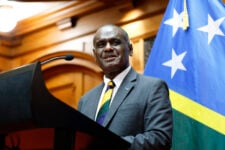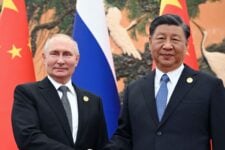
Farnborough International Air Show visitors observe static displays of U.S. military aircraft July 16, 2016. (U.S. Air Force photo by Master Sgt. Eric Burks/Released)
Correction 06/21/2023 at 2:20 am ET: The original version of this story misidentified Cressey as a different individual. This story has been updated to reflect the correct speaker.
PARIS AIRSHOW — In February, the US State Department rolled out its long-awaited changes to the Conventional Arms Transfer policy. Under the new CAT language, the Biden administration said, foreign weapon sales would have to comply with a more stringent human rights standard than before.
Four months into the new guidelines, two State officials say that while the new rules have not led to a major change in approval numbers for arms sales, they have elevated the role human rights considerations play in the process.
Stanley Brown, the principal deputy assistant secretary of state for political-military affairs, told media at the Paris airshow that the CAT policy touches “everything” that State weighs when considering an arms sale, “so that we can make an informed decision on whether to transfer whatever capability that we retrying to transfer. This administration has wanted to put human rights at the forefront in that regard, and we are continuing to do that.”
Both Brown and Laura Cressey, director of regional security and arms transfer, were careful not to say there had been a higher percentage of weapon sales denied since the new policy took effect. Instead, the result is that the human rights offices inside State are being given extra time and more input than previously.
“I think what you see a lot more conversation, a lot more deliberation internally and DRL [the Bureau of Democracy, Human Rights, and Labor] having more of a voice,” Cressey said, referencing the office that has oversight on human rights issues.
“It’s not necessarily that you’re going to see more denials, per se, but you might have us enter into more in-depth conversations with the country that is interested in procuring the item, or are there things that maybe we want the country to do before we provide the equipment? That’s where the difference really lies.”
Noted Brown, “I can’t speak to turning down cases but cases are more scrutinized through that lens … So as actions are taken, we’re having more discussion on cases depending on the situation.”
More broadly, Brown — as of publication the only US government official scheduled to talk to media during the Paris Airshow — said said he was having ongoing conversations with nations that, in the wake of Ukraine, are looking for every piece of military kit they can find.
Global military spending has increased for eight years in a row, he said, and the US is “seeing more demand… rising demand is the new normal in this space, so we’re going to see a continued focus on that.”
On getting weapons to Ukraine, Brown called the scale of the effort “historic,” saying, “We have moved mountain in that regard. Things that used to take months or weeks to get through the approval process across the interagency are happening in a matter of hours.”






















